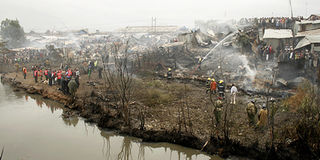It was a scene straight from hell

Firemen and rescue workers at the scene of one of the worst fire tragedies in recent times at Lunga Lunga slum in Nairobi’s Industrial area.
Joan Pereruan | NATION
What you need to know:
- Remains of babies, children and adults were all strewn everywhere after slum fire
It was a scene straight from hell. It was gory.
Six hours after the 8am fire, the scene looked like one cut out from the nastiest of horror movies that Hollywood has ever produced.
As I stepped onto the smouldering site, I began counting bodies. All were burnt beyond recognition. What was left was a mass of black and white and skeletal-like outline of a human being. You could have been in a lab anywhere; only that this was real in the Sinai slum.
The bones had all turned white and if you accidentally stepped on one; it crumbled into ash. The flesh was all black — like badly burnt nyama choma (roast meat).
There were remains of babies, children, and adults all strewn everywhere. Even pigs and piglets lay side by side. If you love pork; you wouldn’t even think about it.
Skulls had turned white, some were cracked; the ribs were white, jutting out from the remainder of the charred body.
If you’ve seen that picture of dead livestock in Kenya’s arid lands at the height of drought, then, picture a body of a human being that’s all turned into bones.
The officialdom; the neighbours; the onlookers and the rest of us just jumped over the bodies as we walked around taking in the scene.
The police did a good job at keeping crowds at bay.
The bodies were not covered: There was a man whose charred remains still had part of his zip. A few others, had their intestines hanging loosely by their sides.
They were faceless bodies; but human beings nonetheless. They were people’s brothers, mothers, fathers and children.
Some more bodies lay in a pile right next to a manhole that had been blown off by the explosion. A body of a pig was sandwiched between two of human beings.
Dozens of bodies lay in a trench, one on top of the other. More bodies lay in the river. There was also one of a woman who died with a child on her arms.
Tears flowed as some neighbours recalled their relatives; but these were subtle. The shock was jaw-dropping; the terror was stomach-churning, and the tragedy of it all was just apocalyptic.
Most of the victims died on their backside.
Assistant Police Commissioner Nelson Munyi from the National Disaster Office looked devastated at the scene.
All he said was: “It is quite unfortunate.” Unlike the normal case where the police are quick with facts Mr Munyi was shocked.
Stormed the slum
I overheard him ask on phone if “arrangements can be made to have a funeral home allow the government to use its cold room in Industrial Area to keep the bodies.”
Embakasi MP Ferdinand Waititu and his Makadara colleague Gidion Mbuvi stormed the scene; but when they saw the extent of the calamity, they quietly walked away.
Government chief whip Johnstone Muthama walked through the scene, spat on the ground and crushed the lump of saliva with new black gumboots. He trudged on, avoiding bodies.
The entourage of Vice-President Kalonzo Musyoka was at the scene preparing for his arrival.
I walked away. I had spent four hours listening to the people re-tell how the fire began and mourning their kith and kin.
A politician’s comment is the last thing I wanted: those people were living in such squalor because of the bad policies.




